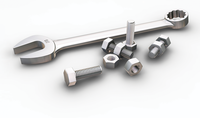
Lead Image © Kirsty Pargeter, 123RF.com
Optimizing Windows Server 2016 performance
Torque Booster
Windows Server 2016's default settings might not always meet your network requirements. Depending on its purpose, the server requires different tweaks to unleash its true performance. In this article, I will be optimizing the RAM, CPU, cache, and storage media.
The performance of Windows Server 2016 depends on the underlying hardware. Ideally, you should use the most up to date Server 2016 hardware possible [1] (e.g., 64-bit processors). The cores should run at the highest possible frequency, because a processor with fewer cores but twice the clock speed can be significantly faster than a processor with several cores and a normal clock speed. Therefore, more cores are not always significantly faster than fewer cores.
Above all, Hyper-V performance benefits from clock speed, because the hypervisor distributes a server's resources to the virtual machines (VMs), which can share a core. In this case, a higher clock speed is infinitely preferable to having more cores that are not used at all by the VM in question.
The RAM performance and size, as well as the storage media's I/O performance, must match the processor. Even if obsolete server hardware can be pimped with new processors, line bottlenecks still can occur quickly if the rest of the server's hardware does not match the new processor's performance.
If you are using Hyper-V, the processor must be able to handle Second Level Address Translation (SLAT). The function is integrated into Intel processors in the form of Extended Page Tables (EPT) and into AMD processors as Nested Page Tables (NPT). The function can be read out with systeminfo.exe and is shown as Second Level Address Translation
. SLAT allows the hypervisor to accelerate memory access.
Measuring in the Right Place
In general, before optimizing, you should use performance monitoring to
...Buy this article as PDF
(incl. VAT)





